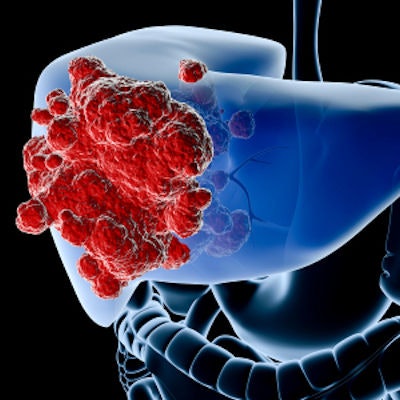
The treatment of liver tumors using yttrium-90 (Y-90) radioembolization brings unusual challenges for interventional radiologists. Documentation of treatment planning, calculation of radiation dosimetry, and placement of radioactive sources are not usually a familiar part of an interventional radiologist's lexicon.
 Erin Stephens.
Erin Stephens.It is these unfamiliar disciplines, along with more comprehensive evaluation and management (E/M) visits, that set Y-90 embolization apart from the more routine interventional radiology cases.
Documentation is critical to be properly reimbursed for this procedure, as it is for all interventional radiology procedures. Each Y-90 case presents its own set of circumstances, and a well-constructed operative report will tell the story of the case step by step.
Each artery or branch into which a catheter is placed for diagnostic imaging or intervention is assigned a separate Current Procedural Terminology (CPT) code, so the operative report must describe with specificity each catheter placement. When these descriptions are in a logical, sequential order, certified coders say they are better able to understand every aspect of the case so they can then accurately identify and apply all of the allowable codes to maximize reimbursement for the procedure. A descriptive evaluation of each artery supports payment of the codes that are submitted for reimbursement.
A typical Y-90 case includes several segments, beginning with the initial patient visit to determine the appropriateness of the procedure. Then there are three distinct phases:
- Pretreatment, which includes diagnostic angiography for pretreatment mapping, tumor localization using nuclear medicine, and treatment planning
- Day of treatment, which includes additional angiography and the Y-90 radioembolization treatment
- Post-treatment, which includes SPECT or PET/CT nuclear medicine scans for tumor localization
Since much of the pre- and post-treatment phases consist of more routine diagnostic procedures, we will focus our attention on the aspects that are applicable to a complex case such as Y-90 radioembolization.
Pretreatment office visit or consultation
When a patient is referred to interventional radiology, the first visit can be billed either as an initial outpatient office visit using CPT 99202-99205 or as an office consultation using CPT 99241-99245. Consultation codes offer higher reimbursement than outpatient office visit codes, and they are appropriate when the interventional radiologist is evaluating the patient to determine if the Y-90 procedure is a viable option.
However, Medicare does not reimburse for these consultation codes; the initial or subsequent office visit codes are always used for Medicare. A consultation requires that the request and reason for the referral be included within the patient's medical record, and a written report of the visit must be issued to the requesting physician, in addition to meeting all of the other criteria for an office visit. The interventional radiologist must continue to keep the requesting physician informed of the outcome of the visit. Any subsequent office visits would be coded using CPT 99211-99215 for established patient office visit, regardless of how the initial visit was coded.
See Appendix A for more details. Note that the rules for coding and billing E/M visits may change as of January 1, 2021. This article is not intended to be a complete guide to E/M visit documentation and coding.
Pretreatment radiation planning
Clinical treatment planning, CPT 77261-77263, is a radiation oncology series of codes that may be used in Y-90 cases. These codes are billed once per case by the authorized user (AU), who could be either the interventional radiologist, if he or she is so qualified, or a radiation oncologist. The AU must document the treatment plan separately from the procedural report.
The treatment planning report includes the following:
- A review of any prior relevant imaging and any biopsy or prior surgery results
- Any treatment already received
- Correlation of the physical exam with such prior testing
- Treatment volume determination
- Toxicity or tolerance concerns
- Treatment time and dosage, sequence of treatment modality
- Determination of the number and size of treatment ports
- Orders and medical necessity for imaging guidance, including frequency and imaging modality
- Any concerns or variables unique to the patient and documentation of care coordination
Basic radiation dosimetry calculation, CPT 77300, is separately billable for the dose calculation portion of the treatment plan when it is performed by an AU other than the interventional radiologist; otherwise, it is bundled with the procedure for the administration of the radiopharmaceutical (CPT 79445, described below).
A calculation worksheet may be used, and the final results are documented in the treatment plan described above. Documentation of dosimetry calculations includes the physician's order, identification of the areas being treated, the calculation of the radiation dose distribution, and evidence that the calculations were reviewed, signed, and dated by the physician. A Y-90 case may include several calculations, each billed separately.
Special physics consult, CPT 77370, may be used at the discretion of the physician in a particular circumstance, and it requires a written request that is signed and dated by the physician. The request must be specific to a particular patient and must address the particular problem and/or service that requires the expertise of a qualified medical physicist. It is billed by the employer of the radiation physicist, not by the physician.
Special treatment procedure, CPT 77470, may be used in cases requiring extra work over and above the basic dosimetry. Use of this code requires documentation of prior treatment and outcomes, review of current CT and liver function studies, and Eastern Cooperative Oncology Group (ECOG) performance status in addition to dose calculation entry. It should be evident that there is additional physician work.
Treatment procedure
Administration of radiopharmaceutical, intra-arterial, CPT 79445, is used to report the delivery of the microsphere dose when only one physician, the interventional radiologist, is involved in the procedure. When a radiation oncologist is the authorized user, then he or she will bill CPT 77778 (interstitial radiation source, complex) instead. CPT 79445 includes the supervision, handling, and loading of the radiation source. The use of CPT 77790 is no longer allowed by Medicare.
Commercial (non-Medicare) payors might have their own coding requirements and payment policies for the procedure. As an example, UnitedHealthcare (UHC) and some Blue Shield plans list Healthcare Common Procedure Coding System (HCPCS) code S2095, transcatheter occlusion or embolization for tumor destruction, percutaneous, any method, using yttrium-90 microspheres, as an applicable code for the procedure along with CPT 79445. The UHC payment policy states that Y-90 radioembolization is medically necessary and therefore will be reimbursed but only for the following indications:
- Unresectable metastatic liver tumors from primary colorectal cancer (CRC)
- Unresectable metastatic liver tumors from neuroendocrine tumors
- Unresectable primary hepatocellular carcinoma (HCC)
To assure reimbursement, a radiologist performing these procedures should check with each patient's insurance carrier for its requirements.
Documentation
The dose administration is done as part of an angiogram and documentation of its placement, including the amount of the dose actually delivered, is contained in the operative report of the angiogram.
Attention to the detailed documentation requirements that support this sophisticated coding and billing is essential, not only to obtain maximum reimbursement for the procedure but also to avoid any potential repayments and fines due to a Medicare Recovery Audit Contractor (RAC) audit or insurance company retrospective review of cases. Elements that are often missing in procedural documentation are fluoroscopy time, sedation start and end times, and specificity of the arteries and anatomic sites accessed.
Structuring the operative report in a logical fashion begins with the basics of patient information, surgical team, fluoroscopy time, sedation times, and indications for the procedure. These items are followed by a hierarchical description of the procedure in the sequence performed, including the various arteries or branches entered. It is important to report these steps in their order so that reviewers, including coders, know what to expect and can understand the complexity of the procedure.
Separate identification of the steps performed by the primary physician, as distinguished from those of the assisting physician, allows the appropriate application of coding modifiers. Just as important as the procedural description is the description of the results of the procedure, which would include a description of the vessels' patency or sclerosis, a diagnostic evaluation of the vessels, and whether or not the embolization procedure was successful.
Adherence to such a structure in creating the operative report will help the physician avoid incomplete reports, and it will enable the coders to bill for every possible aspect of the procedure performed to maximize reimbursement.
Erin Stephens is senior client manager, education at Healthcare Administrative Partners.
The comments and observations expressed are those of the author and do not necessarily reflect the opinions of AuntMinnie.com.



















